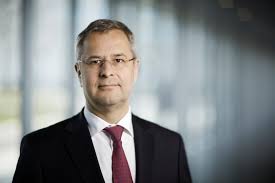A.P. Moller-Maersk improved earnings and free cash flow in 2019, despite weaker market conditions and global container growth of only 1.4 per cent. Earnings before interest, tax, depreciation and amortisation (EBITDA) improved 14 per cent to $ 5.7 billion compared to 2018 and the EBITDA margin increased to 14.7 per cent. Revenue decreased slightly to $ 38.9 billion in 2019 from $ 39.3 billion. Free cash flow was $ 6.8 billion, compared to $ 5.1 billion last year and capex declined by $ 1.2 billion to $ 2 billion in 2019.
“Despite weaker market conditions, A.P. Moller – Maersk was able to improve profitability and cash flow. Our cash return was healthy, and we continued the reduction of net interest-bearing debt, leading to a further deleveraging of $ 3.3 billion over the year. It gives us a solid starting point for 2020 to further expand our end-to-end offering within container logistics while at the same time managing the market challenges that are obviously out there,” says Mr Soren Skou, CEO of A.P. Moller – Maersk.
In Ocean, EBITDA in 2019 increased 15 per cent to $ 4.4 billion and the EBITDA margin of 15.3 per cent increased by 2 percentage points, driven by a lower cost base. Revenue was $ 28.4 billion with a small decrease in volumes to 13.3 million FFE. Unit cost at fixed bunker decreased by 1.7 per cent, mainly due to improvements in capacity management and foreign exchange rate developments.
In 2019, EBITDA in Logistics & Services increased 24 per cent to $ 238 million with an EBITDA margin of 4 per cent, while revenue decreased slightly to $ 6 billion from $ 6.1 billion, driven by a decrease in sea and air freight forwarding activity, which was only partly offset by an increase in warehousing and distribution.
Terminals & Towage reported an increase in EBITDA of 11 per cent to $1.1 billion with an EBITDA margin of 28.4 per cent in 2019. Revenue increased 3.2 per cent to $ 3.9 billion. In gateway terminals, EBITDA increased by 17 per cent to $ 902 million, reflecting an increase in EBITDA margin to 28 per cent and revenue increased by 4.1 per cent to $ 3.2 billion. The positive development was driven by a ramp-up of the new terminal in Moin, Costa Rica, higher volumes, higher storage income and reduction in SG&A.
Net interest-bearing debt decreased through the year to $ 11.7 billion from $ 15 billion in 2018. In 2019, $ 1.3 billion was distributed to shareholders via ordinary dividends and share buy-backs. An ordinary dividend equal to $ 469 million was paid to shareholders and as part of the share buy-back programme announced in May 2019, the company bought back shares worth $ 791 million.
A stronger foundation from improved operational performance and better customer experience
The strategic focus of 2019 was on improving the financial performance on Ocean and creating a better customer experience through increased reliability, improved customer experience and introduction of online services and products such as Maersk Spot, a unique product in the market that offers price and loading guarantee. Also, during the year, we took further steps in the integration of the business on a structural level and how we go to market.
“While we still need to improve returns, we delivered solid progress in our financial performance in 2019 while progressing the business transformation, in spite of weak trade growth, ongoing trade tensions and geopolitical uncertainty in many markets,” explains Mr Soren Skou.
Maersk reported a cash return on invested capital improvement (CROIC) for the full year of 9.3 per cent due to strong cash flow.
Furthermore, non-Ocean revenue increased by 0.1 per cent, when adjusted for the closing of production facilities in Maersk Container Industry. Strong revenue growth in gateway terminals was offset by declining freight forwarding activities. Gross profit in Logistics & Services grew 8.7 per cent to $ 1.2 billion, reflecting a gross profit margin of 20 per cent.
Synergies harvested from the Hamburg Süd acquisition and the integration of transport and logistics reached $ 1.2 billion, which is above the expected target.
The long-term target on return on invested capital after tax (ROIC) grew to 3.1 per cent in 2019, compared to 0.2 per cent the year before.
Guidance for 2020
A.P. Moller Maersk expects an EBITDA of around $ 5.5 billion, before restructuring and integration costs.
The organic volume growth in Ocean is expected to be in line with or slightly lower than the estimated average market growth of 13 per cent for 2020.
The outlook and guidance for 2020 is subject to significant uncertainties and impacted by the current outbreak of the Coronavirus in China, which has significantly lowered visibility on what to expect in 2020. As factories in China are closed for longer than usual in connection with the Chinese New Year and as a result of the Coronavirus, we expect a weak start to the year.
The guidance for 2020 is also subject to uncertainties related to the implementation of IMO 2020 and the impact on bunker fuel prices and freight rates combined with the weaker macroeconomic conditions and other external factors.
The accumulated guidance on capex for 2020-21 is still $ 34 billion. A high cash conversion (cash flow from operations compared to EBITDA) is expected for both years.






